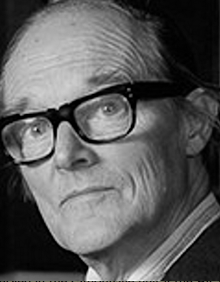
Hugh Maxwell Casson was born in north London, England on 23 May 1910. He studied at St John's College, Cambridge (1929-31), the Bartlett School of Architecture, University College London (1931-32) and the British School in Athens (1933). Whilst studying at the Bartlett, he met Margaret MacDonald Troup [Margaret MacDonald Casson] whom he married on 9 November 1938.
Between 1933 and the outbreak of World War Two in 1939 Casson worked in the London office of his former Cambridge tutor, Christopher (Kit) Nicholson (1904-1948). He also at the same time taught at the Cambridge School of Architecture. During the war he served in the camouflage unit if the Air Ministry (1940-44).
From 1946 he was in partnership with Neville Conder. In 1956 the practice became Casson Conder Partnership.
He was Director of Architecture for the 1951 Festival of Britain (1948-51). Between 1953 and 1974 Casson was Professor of Interior Design at the Royal College of Art in London.
He was elected an Associate of the Royal Institute of British Architects (ARIBA) in 1934 and later a Fellow of the Royal Institute of British Architects (FRIBA). In 1970 he was made a Royal Academician (RA) and was subsequently President of the Royal Academy (1976-84). He was also a Fellow of the Society of Industrial Artists and Designers (FSIAD) and was an Honorary Associate of the American Institute of Architects (Hon.AIA) and a member of the Royal Danish Academy. He was elected a Royal Designer for Industry (RDI) by the Royal Society of Arts in 1951 and knighted for his services to architecture in 1952. Casson died in London on 15 August 1999.
Projects by Casson and Conder and the Casson Conder Partnership included a stand for Arthur Sanderson & Sons Ltd. at the Ideal Home Exhibition in London (1949); British pavilion at the Van Riebeck Festival Fair in Cape Town, South Africa (1952); street decorations in Westminster, London for the coronation of Queen Elizabeth II (1953); the Royal apartments HMY 'Britannia' (1953, 1983); the Royal apartments and guest suites at Windsor Castle (1954-83); interiors on the S.S. 'Canberra' for the P & O Orient Lines (1961); the Hall of Residence at Worcester College, Oxford (1962); the Elephant Rhinoceros Houses at London Zoo (1965); the Science section in the British Pavilion at Expo '70 in Osaka, Japan (1970); the Library at Badmington School in Bristol (1974); the headquarters building of W.H. Smith in London (1976) the Study Centre at London Zoo (1976); the Royal apartments on the Royal Train (1977); and the Ismaili Centre in South Kensington, London (1983).
Casson also designed stage sets for the Royal Opera House, Royal Court Theatre, and Palace Theatre in London and for Glyndebourne Opera House in Gyndebourne, Sussex; and at least one poster - 'Rome' for BEA British European Airways which is illustrated in 'Graphis' vol.9, no.46, 1953 (p.126). Casson was the author of several books, some of which he illustrated himself.
Brock, Dave. 'Conversation with Casson'. Journal of the Royal Architectural Institute of Canada vol. 37, February 1960 pp. 72-73
Manser, José. Hugh Casson: a biography. London: Viking Books, 2000. ISBN 10: 067087115XISBN 13: 9780670871155
Richards, J. M. 'Criticism: Youth Hostel at Holland Park, London'. Architects' Journal vol. 131, 18 June 1059 pp. 911-915 [Critical article on a youth hostel designed by Sir Hugh Casson]
Wharton, Kate. 'Talking to Sir Hugh Casson'. Architect and Building News vol. 2, 29 January 1969 p. 27